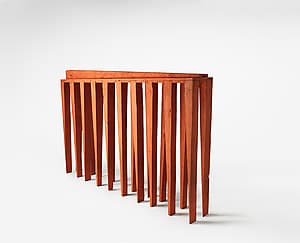

Louise Bourgeois
Learn moreC.O.Y.O.T.E. 1941-48
© The Easton Foundation. VAGA/Copyright Agency Purchased 1981
More detail | PermalinkOne of Louise Bourgeois’ earliest major sculptures, C.O.Y.O.T.E. 1941–48, and two related pieces, both titled The blind leading the blind,[i] were begun in 1941 when increased studio space gave her the opportunity to work on a large scale for the first time. This was a turning point in her career, the artist reflected in 1979, ‘because we moved to the so‑called Stuyvesant Folly, which had an immense roof where nobody ever went and I spent my time there. It was very large and I could leave my pieces without being bothered. At this point the size and number of pieces changed.’[ii] Lucy Lippard has pointed out that the combination of human and architectural elements in these sculptures—legs and lintel—can be found in Bourgeois’ earlier works: drawings, paintings and small carved and painted wooden sculptures in which tall, narrow buildings sprout stilts or legs.[iii] When she first arrived in New York from Paris in 1938, Bourgeois recalled being ‘struck by the brownstones, which were a form of habitat I had never seen, and since they were very large and very high and very narrow they reminded me of the human body’.[iv]
Bourgeois herself traced the genesis of C.O.Y.O.T.E. and The blind leading the blind to childhood memories, when she and her brother crouched beneath the kitchen table watching the legs of their parents move back and forth as they prepared a meal.[v] Referring specifically to this work, she said:
It represents an army of legs, two by two, that holds together. Eight pairs of legs. The reason this blind army of legs does not fall, even though the legs are always afraid of falling, since they come to a point, is that they hold on to each other. This is exactly what I felt when I was a child, when I was hiding under the table. My brother was following me like a shadow; I was blind with fear and so was he … [and I concluded that my parents] were not friendly. I decided that the outside was not friendly. And I was afraid, simply afraid. I couldn’t understand their purpose, which was to prepare lunch. I didn’t understand why they were walking around the table. Why would one pair of legs interfere with the other visually, physically? There were their legs and the table’s legs. It really just made me wonder where I fitted in.[vi]
If the form of these sculptures owed something to childhood memories, their title The blind leading the blind—a title that was also originally applied to C.O.Y.O.T.E.—had a very contemporary relevance for Bourgeois. Taken from the New Testament (Matthew 15:14: ‘if the blind lead the blind, both shall fall into the ditch’), the title was chosen for works in which the artist saw ‘catastrophe’, ‘a chain of pain’, ‘people fated to be destroyed together’.[vii] The sculptures were made at the height of the Cold War, at a time when her friends, the artists Marcel Duchamp, Amédée Ozenfant and André Lhote, were under investigation by the House Un-American Activities Committee, suspected of being Communists.
In 1979, in preparation for her exhibition at the Xavier Fourcade Gallery in September, Bourgeois gave a new title to one of The blind leading the blind sculptures, and repainted it, covering the original black and red colour scheme with flesh‑pink paint. The new title, C.O.Y.O.T.E., stands for ‘Call Off Your Old Tired Ethics’ and was taken from a tract written by Bourgeois’ friend Margot Saint James, in which she argued the right of prostitutes to a reasonable workers’ organisation, that is, the right to belong to a union. Bourgeois explained:
The blind leading the blind is a piece that brings me to the feminist cause. Another, which is very close, is C.O.YO.T.E., which was the name of the prostitutes’ group. All they can do is hold on to each other. Individually they couldn’t even stand on their feet, but holding on to each other, they make it. It’s also a comment on failures, on shortcomings, on being disabled. They huddle together, and through their positive attitude toward each other they summon the energy necessary to stand against the world. They conquer fear enough to finally express themselves and be what they are.[viii]
C.O.YO.T.E., in declaring Bourgeois’ allegiance to the collective, suggests both the right to self-determination and a rallying cry for the oppressed everywhere.
Christine Dixon[ix]
[i] The blind leading the blind 1949, Detroit Institute of Arts, at https://www.dia.org/art/collection/object/blind-leading-blind-35229, accessed 16 February 2018, and The blind leading the blind 1941–48, collection of the artist, New York.
[ii] Bourgeois, quoted in Marsha Pels, ‘Louise Bourgeois: A Search for Gravity’, Art International, vol 23, no 7, October 1979, p 51.
[iii] Lucy R Lippard, ‘The blind leading the blind’, Bulletin of the Detroit Institute of Arts, vol 59, no 1, Spring 1981, p 27.
[iv] Corinne Robins, ‘Louise Bourgeois: Primordial Environments’, Arts Magazine, vol 50, no 10, June 1976, pp 81–3.
[v] Kay Larson, ‘Louise Bourgeois: Body language spoken here’, Village Voice, 24–30 September 1980, p 83.
[vi] Donald Kuspit, Bourgeois: an interview with Louise Bourgeois, Vintage Books, New York, 1988, pp 26–7.
[vii] Lippard, p 27.
[viii] Kuspit, pp 70–2.
[ix] Adapted and updated from Michael Lloyd and Michael Desmond, European and American Paintings and Sculptures 1870–1970 in the Australian National Gallery, Australian National Gallery, Canberra, 1992, pp 209–11.

